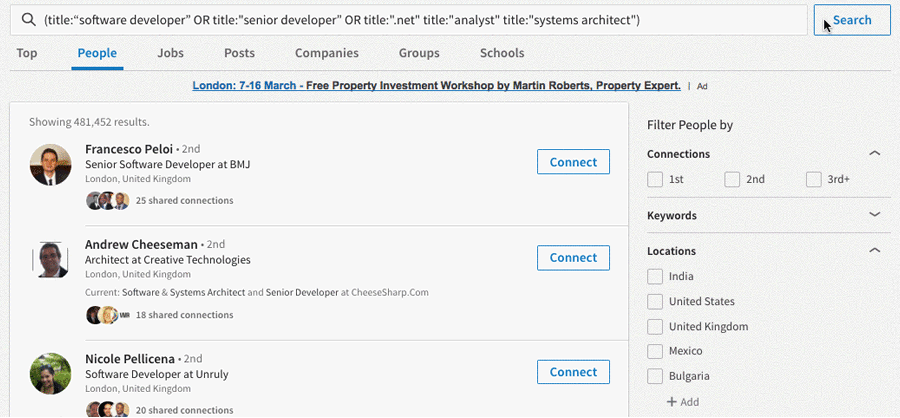Did you like many of us fail to heed the omens? The writing on the wall, as early as September.
But now you’ve jumped onto your computer ready for some advanced searching wizardry and it’s all different. It’s okay we were shocked, we’re all a little averse to change, but it’s where we go from here that matters.
The first thing that you might have noticed gone from your bar is the Advanced Search function, and then you might notice your Individual Search Fields feature has also gone; a vital arrow to your Recruiter quiver.

In a recent article on the changes to search, LinkedIn have stated:
In this redesign, you now have one single search box at the top of every LinkedIn page to find People, Jobs, Companies, Groups and Schools.
And they listed out a few tips, on finding Specific People and Job Searches, these handy videos explain it.
But this is small-fry for us Recruitment search masters.
Well LinkedIn has brought back an old search feature, called Field Commands – You may have used these for Google and Bing. If you use these Field Commands correctly you will be able to significantly narrow down your search results – something like Advanced Search.
These Field Commands will be coupled with the all too familiar Boolean operators; such as AND, OR and NOT. Now pay close attention because, just like writing code this all has to be done in a specific way.
So here’s your list of Field Commands, currently supported:
title:
company:
school:
firstname:
lastname:
And here’s your list of Boolean operators:
AND
OR
NOT
Remember that these Field Commands must always be in lower-case, while your Boolean must always be Capitalised. And when we supply a keyword for your Field Command place it directly after the colon, No Spaces.
Let’s see this in action
title:developer
company:google
And let’s further this search:
(title:“software developer” OR title:c# OR title:developer OR title:”senior developer”)
When you’re using terms that use multiple-words, use Parentheses “Like This” – And to get the most of your Boolean Operators with your Field Commands you need to put the correct Field Command before each individual keyword.

Now if I then add a location into the search option to the left, then we can start narrowing down our results.
Let’s start to get even more specific by making better use of our Boolean buddies. We’re going to use the NOT operator to trim off unsuitable candidates.
Now, forget what you know from the old way of doing this, because again there’s a specific way to get the results that you need.
So we’ve ended up with a large number of Software Developers still, and we’re not interested in Python, Java, Ruby developers, so with NOT we can strip them from our results.
(title:“software developer” OR title:c# OR title:developer OR title:”senior developer” NOT python NOT java NOT ruby)
As before, you can also use the minus – symbol, yet the way you’ll construct this is a little different.
(title:“software developer” OR title:c# OR title:developer OR title:”senior developer” (-(python AND java AND ruby)) )
Your minus bracket will need to be contained in its own separate set of brackets (-()) then you’ll also need to add the keywords in a set of brackets, inside of the minus brackets.
Remember your brackets need a opening and close, if you’re having issues with your results, perhaps check all brackets are correct.
(-(this OR is OR an OR example))
And remember you can specify Field Commands in your minus code:
(-(company:microsoft AND company:apple AND company:amazon))
And there we have it – You’ll certainly need to put in a lot more work, for some of you this might be familiar territory, and some this might be all brand new.
Additionally although LinkedIn has very recently added Sticky Filters (Remembering your search filters until specifically cleared) and a feature called Saved Searches (also known as search alerts: Giving you the ability to save and reuse your searches) We’d still recommend you go ahead and keep a handy little document to store your best search lines in.
Enjoyed our article? – Subscribe for more!
Receive weekly insights right in your Inbox. Unsubscribe anytime!
Share :



